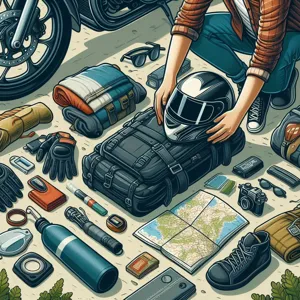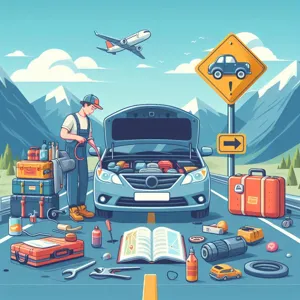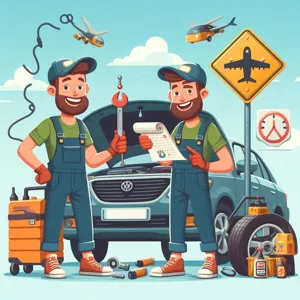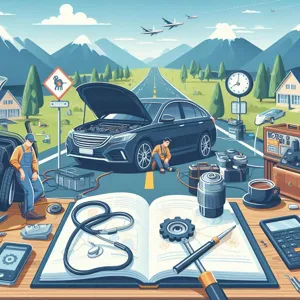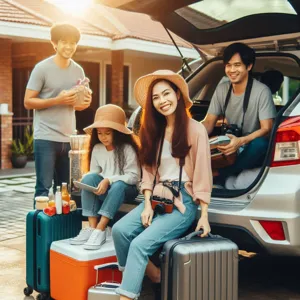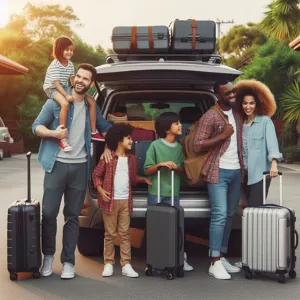Embarking on an exhilarating journey on two wheels is one of life’s greatest thrills, but navigating the open road can sometimes feel daunting without the right tools.
Enter the motorbike GPS—a game-changing device that transforms your ride into an adventure filled with undiscovered paths and breathtaking vistas. Whether you’re a seasoned rider or a newcomer eager to explore, mastering your motorbike GPS can unlock a world of possibilities, guiding you through scenic routes while helping you avoid the pitfalls of getting lost. In this blog post, we will delve into the essential features and functionalities of motorbike GPS systems, offering tips and tricks to optimize your experience. From planning the perfect route to discovering hidden gems along the way, get ready to rev up your engine and embark on the ultimate ride!
1. Introduction to Motorbike GPS: Why It Matters

In the world of motorbiking, the thrill of the open road is matched only by the allure of exploration. However, the freedom to roam can often lead to uncertainty. This is where a Motorbike GPS comes into play, transforming your riding experience from merely navigating from point A to point B into an exhilarating adventure filled with unexpected discoveries. But why does it matter?
First and foremost, a Motorbike GPS is more than just a map; it’s your personalized co-pilot, guiding you through unfamiliar territories while keeping you safe. Unlike traditional maps that require constant stopping and fumbling, a GPS provides real-time navigation, allowing you to focus on the road ahead and the exhilarating journey rather than getting lost in the details. With voice-guided directions, you can keep your eyes on the road, ensuring a safer ride.
Furthermore, the technological advancements in modern GPS systems offer features that cater specifically to motorcyclists. From tracking scenic routes that enhance your riding experience to avoiding heavy traffic and road construction, these devices can tailor your journey to fit your adventurous spirit. Additionally, many GPS units come equipped with weather alerts, points of interest, and even the capability to connect with other riders, creating a network of shared experiences along the way.
Lastly, having a reliable GPS system can give you the confidence to explore new areas that you might have otherwise avoided due to fear of navigating unknown roads. It empowers you to venture off the beaten path and discover hidden gems—whether it’s a breathtaking overlook, a quaint diner, or an intriguing backroad that beckons you to explore.
In short, mastering your Motorbike GPS is not just about reaching your destination; it’s about enhancing the journey itself. With the right tools at your disposal, every ride can be a new adventure, filled with opportunities to create unforgettable memories on two wheels. So, let’s dive into the essential tips and tricks for unlocking the full potential of your Motorbike GPS, ensuring that your next ride is not just a trip, but an epic adventure waiting to unfold.
2. Choosing the Right GPS for Your Motorbike
Choosing the right GPS for your motorbike is a critical step in unlocking the full potential of your riding adventures. With a multitude of options available, it’s essential to consider several key factors that will enhance your navigation experience and ensure you stay on the right path—literally and figuratively.
First and foremost, think about the specific features that cater to motorcyclists. Look for a GPS device that offers robust route planning capabilities tailored to two-wheeled travel. Features such as motorcycle-specific routing, which avoids unpaved roads and overly steep inclines, can save you from unwanted detours and enhance your journey. Additionally, a good motorbike GPS should provide real-time traffic updates and weather alerts, allowing you to adapt your route and avoid hazardous conditions.
Durability is another crucial aspect to consider. Motorbikes endure various weather conditions, so opt for a GPS that is waterproof, shock-resistant, and designed to withstand the vibrations of a motorcycle. Many models come with rugged screens that are easier to read in bright sunlight, ensuring that you can quickly glance at your device without missing a beat on the road.
Screen size and interface are also important. A larger screen can make navigation easier, especially when you’re on the move. Look for a GPS with a user-friendly interface that allows you to input destinations and access information with minimal distractions. Voice command features can also enhance safety by allowing you to keep your hands on the handlebars and your eyes on the road.
Finally, consider the GPS’s connectivity options. Many modern devices sync with smartphones and other gadgets, allowing you to access your contacts, playlists, and even navigation apps directly from your GPS screen. This connectivity not only enhances your riding experience but also keeps you engaged without compromising safety.
By carefully considering these factors, you can select a GPS that not only meets your navigation needs but also enriches your overall riding experience. With the right device in hand, you’ll be well-equipped to embrace the open road and embark on unforgettable adventures.
3. Setting Up Your Motorbike GPS: A Step-by-Step Guide
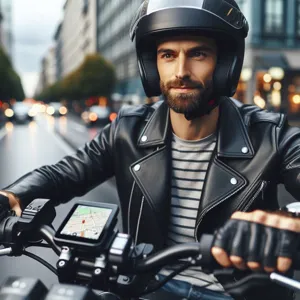
Setting up your motorbike GPS is an essential step to ensure that your adventures on two wheels are both enjoyable and safe. With the right knowledge and tools, configuring your device can be a straightforward process that enhances your riding experience. Here’s a step-by-step guide to get you started:
**Step 1: Choose the Right Mounting Location**
Begin by selecting the optimal spot on your motorbike to mount the GPS. The ideal location is one that allows for easy visibility without obstructing your view of the road. Typically, the handlebars or a dedicated GPS mount on the dashboard work well. Ensure the mount is secure and stable to avoid vibrations that can affect the device’s performance.
**Step 2: power Up Your Device**
Once securely mounted, connect your GPS to a power source. Most motorbike GPS units come with a hardwired option to your bike’s battery or can be powered through a USB connection. If hardwiring, consider enlisting the help of a professional to ensure proper installation and to avoid any electrical mishaps.
**Step 3: Initial Setup and Configuration**
Turn on your GPS and follow the on-screen prompts to set up your device. This usually involves selecting your language, time zone, and other preferences. Take a moment to customize settings such as map views, voice commands, and route preferences. Many modern GPS systems allow you to choose between scenic routes, fastest routes, or even off-road paths, so tailor it to your riding style.
**Step 4: Download Maps and Updates**
Before hitting the road, make sure your maps are up-to-date. Connect your GPS to your computer or use a smartphone app to download the latest maps and firmware updates. This step is crucial as it ensures you have access to the most accurate and detailed routes, which can make a significant difference during your rides.
**Step 5: Plan Your Routes**
Utilize your GPS to plan out your route before you set off. Input waypoints, favorite destinations, or even points of interest along the way. Some GPS devices also allow for route sharing, so you can exchange your favorite rides with fellow motorbike enthusiasts.
**Step 6: Familiarize Yourself with Features**
Take some time to explore the various features your GPS offers. Many devices come equipped with built-in features such as altimeter readings, weather updates, and traffic alerts. Understanding these functionalities will make you a more confident rider and improve your navigation capabilities.
**Step 7: Test It Out**
Before embarking on a long journey, take your motorbike GPS for a short test ride. This will help you get accustomed to how the device operates while in motion. Make adjustments as necessary, ensuring that you can easily read the screen and access features without distraction.
By following these steps, you’ll be well on your way to mastering your motorbike GPS. Not only will it enhance your riding experience, but it will also help you explore new terrains with confidence, knowing that you have a reliable navigator by your side. So gear up, set your GPS, and get ready to unlock the adventure that awaits on the open road!
4. Understanding GPS Features: What to Look For
When it comes to selecting the right GPS for your motorbike, the myriad of features available can be overwhelming. Understanding what to look for is essential to ensure you have a device that not only meets your navigation needs but also enhances your riding experience.
First and foremost, consider screen visibility. A bright, high-resolution display is crucial, especially when you’re riding in varying light conditions. Look for a screen that is designed to resist glare from the sun, ensuring you can easily read directions without squinting or risking a glance away from the road. Touchscreen capabilities can add convenience, but ensure it’s responsive even with gloves on, as that’s often a necessity for motorcyclists.
Next, pay attention to the GPS’s routing options. Some devices offer motorcycle-specific routing, which takes into account factors such as road types, curves, and elevation changes. This feature is invaluable for those who prefer scenic, winding roads over the fastest route. Additionally, check for customizable routes—this allows you to plan adventures that align with your preferences, whether that means avoiding highways or seeking out particular landmarks along the way.
Another important feature to consider is connectivity. A GPS that can sync with your smartphone can provide real-time weather updates, traffic alerts, and even access to music or communication apps. This connectivity can be a game-changer, allowing you to stay informed without taking your focus off the road.
Don’t overlook the importance of battery life and durability. A robust GPS that can withstand the elements is essential for any adventure rider. Look for devices that claim water resistance and shock resistance, ensuring that your investment is protected, even in the roughest conditions.
Lastly, consider additional features like built-in Bluetooth for hands-free communication, voice command capabilities for easy navigation, and even points of interest (POI) databases that highlight landmarks, gas stations, and eateries along your route. By understanding these key features, you can select a motorbike GPS that not only guides you reliably but also transforms your rides into unforgettable journeys filled with the thrill of exploration.
5. Planning Your Route: Tips for the Ultimate Adventure

When it comes to planning your route for the ultimate adventure on two wheels, the possibilities are as vast as the open road itself. A well-planned route not only ensures you reach your destination but also enhances the thrill of the journey, transforming a simple ride into an unforgettable experience. Here are some essential tips to help you master your motorbike GPS and craft the perfect route.
**1. Start with the Big Picture:** Before diving into specific roads, take a step back and consider your overall adventure. What kind of terrain do you want to explore? Are you drawn to winding mountain roads, picturesque coastal highways, or serene countryside trails? Use your GPS to mark key points of interest along the way, such as national parks, scenic overlooks, or charming towns. This will help you create a roadmap that balances thrilling rides with memorable stops.
**2. Embrace the Curves:** Motorcycling is all about the ride, and nothing beats the exhilaration of navigating a series of twisting roads. When planning your route, look for highways or backroads that are known for their curves and elevation changes. Many GPS systems have a feature that allows you to search for “scenic routes” or “curvy roads.” By prioritizing these paths, you can maximize the enjoyment of your ride, making every turn a new adventure.
**3. Factor in Fuel and Breaks:** Don’t let the excitement of the journey overshadow the necessities of the ride. Plan your route with regular fuel stops in mind, especially if you’re venturing into remote areas where gas stations may be few and far between. Additionally, consider incorporating breaks to stretch your legs and recharge. Whether it’s a quick coffee stop at a local café or a picnic at a scenic viewpoint, these breaks can enhance your ride and give you a moment to savor the adventure.
**4. Stay Flexible:** While it’s important to have a planned route, being open to spontaneity can lead to some of the most memorable experiences. Your GPS is a fantastic tool for navigation, but it doesn’t dictate your journey. If you stumble upon a hidden gem or a breathtaking vista that wasn’t on your itinerary, don’t hesitate to take a detour. Sometimes, the best adventures are the ones you didn’t plan!
**5. Test Your Route:** Before hitting the road, take a few moments to review your planned route on your GPS. Check for any construction updates, road closures, or potential hazards that could affect your ride. If possible, consider doing a quick test run of sections of the route to familiarize yourself with the terrain and any challenges you might face. This prep work will not only boost your confidence but also help you anticipate any adjustments you may need to make on the fly.
By mastering the art of route planning with your motorbike GPS, you can unlock a world of adventure that awaits just beyond the horizon. Embrace the journey, revel in the ride, and let every twist and turn lead you to new discoveries. The open road is calling—are you ready to answer?
6. Using Waypoints and Routes Effectively
Using waypoints and routes effectively can transform your riding experience from mundane to extraordinary. Waypoints act as important markers on your journey, guiding you to key destinations and points of interest along your route. By strategically placing waypoints, you can create a customized path that not only enhances your navigation but also enriches your adventure with scenic stops, local attractions, or hidden gems that you might not stumble upon otherwise.
Start by planning your ride in advance. Whether you’re aiming for a scenic mountain pass, a quaint roadside diner, or a breathtaking viewpoint, input these locations as waypoints in your GPS. This lets you maintain a flexible itinerary while ensuring you don’t miss out on the highlights that make your trip special.
Moreover, using routes effectively means being familiar with the various navigation options your GPS offers. Many devices allow you to choose between the fastest route, the most scenic route, or even a motorcycle-friendly path that avoids heavy traffic or rough terrains. Don’t hesitate to experiment with different route settings to find what works best for you and your riding style.
As you ride, keep an eye on your GPS for real-time updates and rerouting options. If you encounter an unexpected detour or stumble upon a picturesque road that wasn’t in your original plan, your GPS can help you adjust your waypoints on the fly, allowing for spontaneity and exploration.
Remember, the goal is not just to reach your destination, but to enjoy the journey. With the strategic use of waypoints and routes, you can unlock a world of adventure on two wheels, creating memories that will last a lifetime. So, gear up, and let your motorbike GPS be your trusted companion on the open road!
7. Real-Time Traffic Updates and Weather Integration

In the world of motorbiking, every ride is an adventure waiting to unfold. However, the thrill of the open road can quickly be dampened by unexpected traffic jams or inclement weather. This is where the power of real-time traffic updates and weather integration comes into play, transforming your GPS into an indispensable companion on your journeys.
Imagine cruising down a winding road, the wind in your hair, when suddenly, your GPS alerts you to a traffic delay ahead. With real-time traffic updates, you can easily reroute to bypass congestion and keep your ride smooth and enjoyable. Many modern GPS systems not only provide live traffic information but also predict potential slowdowns based on historical data, helping you plan your route proactively.
But it’s not just about avoiding traffic; the weather can change in the blink of an eye. Having access to real-time weather updates allows you to prepare for any sudden downpours or chilly winds that could otherwise disrupt your ride. Your GPS can provide alerts for severe weather conditions, suggest alternative routes, or even inform you of nearby shelters if needed.
Integrating these features into your motorbike GPS not only enhances your safety but also elevates the overall experience. You can ride with confidence, knowing you’re equipped with the most up-to-date information at your fingertips. Whether you’re embarking on a weekend getaway or a long-distance tour, mastering these tools ensures that every journey remains an adventure worth remembering. So gear up, stay informed, and let your GPS guide you to new horizons, rain or shine!
8. Customizing Settings for Optimal Performance
Customizing your motorbike GPS settings is essential for unlocking the full potential of your riding experience. A standard GPS unit can serve its basic function, but taking the time to tailor its features to your personal preferences can transform your rides from ordinary to extraordinary.
Start by adjusting the display settings to suit your visibility needs. Whether you prefer a bright and bold color scheme or a more subdued interface, ensuring that the screen is easily readable in various lighting conditions is crucial. Many GPS devices offer customizable fonts and layouts, allowing you to prioritize the information most important to you—be it speed, distance to destination, or estimated time of arrival.
Next, explore the route settings available on your GPS. Opt for the “motorbike” routing option if it’s available; this feature often directs you along scenic backroads, bypassing highways and busy urban areas. Consider tweaking the avoidance settings to steer clear of toll roads or unpaved paths, depending on your preferences. For the adventurous rider, enabling off-road routes can lead to thrilling explorations on less-traveled trails.
Voice navigation is another critical setting to customize. Tailor the volume and voice type to ensure clear communication while you ride. A well-placed voice prompt can keep you focused on the road ahead, providing timely directions without distracting you from the thrill of the ride.
Lastly, take advantage of any available connectivity options. Sync your GPS with your smartphone for live updates on weather conditions or traffic alerts. Some devices even allow you to share your location with friends or family, adding a layer of safety to your adventures.
By investing time in customizing your GPS settings, you not only enhance your navigation experience but also open doors to new and exciting routes. The road ahead is full of possibilities; with a few adjustments, your motorbike GPS can be your trusted companion in the journey of a lifetime.
9. Safety First: Using GPS While Riding
When it comes to adventure riding, the thrill of the open road is unmatched, but safety should always be your top priority. Utilizing GPS technology can enhance your riding experience, but it must be approached with caution to ensure that you remain focused on the journey ahead.
Firstly, familiarize yourself with your GPS device before you hit the road. Spend some time in a safe environment to learn its features, functions, and settings. This ensures that you’re not fumbling with controls while navigating through challenging terrains or busy traffic. Many modern motorbike GPS units come with voice navigation, which allows you to keep your eyes on the road while still receiving real-time directions. This hands-free option is a game changer, as it minimizes distractions and keeps your attention where it belongs—on the ride.
Additionally, consider mounting your GPS device in a position that is easily visible without obstructing your view of the road. A secure and well-placed mount can help you quickly glance at your route without the need for excessive movements that can lead to loss of control. Regularly check your route and remain aware of the surroundings; GPS can occasionally lead you astray, especially in remote areas where signals may falter.
Moreover, it’s wise to download offline maps for your GPS unit, particularly if you plan to venture into regions with limited cellular coverage. This precaution ensures that you won’t find yourself lost without guidance. Remember to also share your route with someone before you leave, so they know your intended path. This adds an extra layer of safety, allowing someone to track your journey and check in on you during your ride.
Lastly, make it a habit to stop and take breaks to reassess your route, adjust your settings, or simply enjoy the scenery. Riding with a GPS is about enhancing your adventure, not rushing through it. Prioritizing safety ensures that each ride is not only exhilarating but also secure, allowing you to unlock the full potential of your motorbike adventures. With the right approach to using your GPS, you can navigate with confidence and enjoy every twist and turn the road has to offer.
10. Troubleshooting Common GPS Issues
As with any technological device, your motorbike GPS may occasionally run into some hiccups that can put a damper on your adventure. Knowing how to troubleshoot these common issues can save you time and frustration on the road.
One frequent problem is the GPS failing to acquire a satellite signal. If this happens, try moving your bike to a more open area away from tall buildings or dense foliage, as these obstacles can interfere with the satellite signal. Additionally, giving your device a few minutes to recalibrate can often resolve the issue, so don’t be in too much of a hurry to hit the road.
Another common issue is incorrect or outdated maps. If your GPS is directing you down a one-way street or delivering you to a non-existent destination, it might be time for a map update. Many GPS devices allow you to download the latest maps directly from the manufacturer’s website, ensuring you have the most accurate and reliable navigation at your fingertips.
Battery life can also be a concern during long rides. If you notice your GPS draining faster than expected, check for any power-hungry features that may be running in the background, such as Bluetooth connectivity or real-time traffic updates. Turning off these features can extend your device’s battery life significantly. Additionally, consider investing in a reliable mount that connects to your bike’s power supply, keeping your GPS charged and ready for action.
Finally, if you find that your GPS is providing inconsistent directions or suddenly resets, it may be time for a factory reset. This process restores your device to its original settings, erasing any glitches that may have developed over time. Just be sure to back up your favorites and saved routes before doing so, as you wouldn’t want to lose your best-planned rides!
By mastering these troubleshooting tips, you can ensure that your motorbike GPS remains a trusted companion on all your adventures, guiding you through winding roads and uncharted territory with confidence and ease. Happy riding!
11. Accessories to Enhance Your GPS Experience
When it comes to mastering your motorbike GPS and ensuring every ride is an unforgettable adventure, the right accessories can make all the difference. Think of these enhancements as your toolkit for a smoother journey, elevating both functionality and comfort.
**1. Mounting Solutions:** A high-quality mount is essential for keeping your GPS secure and accessible. Opt for a sturdy, vibration-resistant mount that allows for easy viewing while you ride. Look for options that offer adjustability, ensuring your GPS is positioned perfectly, whether you’re navigating tight turns or cruising along open roads.
**2. Waterproof Cases:** Weather can be unpredictable, and protecting your GPS from rain and splashes is crucial. Invest in a durable waterproof case that not only shields your device from the elements but also allows for full touchscreen functionality. This way, you can navigate with ease, even in less-than-ideal conditions.
**3. Bluetooth Headsets:** Staying connected while on the road enhances your riding experience. A Bluetooth headset allows you to receive turn-by-turn directions audibly, ensuring you stay focused on the road ahead. Additionally, many headsets come equipped with hands-free calling features, letting you communicate without taking your hands off the handlebars.
**4. Power Solutions:** Long rides can drain your GPS battery, so having a reliable power source is vital. Consider investing in a USB charging port that connects directly to your bike’s battery. This ensures your device stays charged for the entire journey, allowing you to explore without fear of losing navigation mid-ride.
**5. Smartphone Integration:** Many modern GPS systems offer smartphone integration, allowing you to access navigation apps and other features seamlessly. If your GPS supports this, explore the available accessories for better connectivity. You can also use your smartphone as a backup navigation tool, ensuring you’re never lost, no matter what.
**6. Customizable Mounts:** If you like to switch between different devices or want to use your GPS for other adventures, consider a versatile mount that accommodates various devices. This adaptability means you can use your GPS not just for motorbiking, but for hiking, cycling, or even in your car.
With these accessories in your riding arsenal, you’ll enhance your GPS experience, ensuring that every journey is not just about reaching your destination, but savoring the thrill of the ride itself. Investing in the right tools can transform your GPS from a simple navigation aid into an indispensable partner for unforgettable adventures.
12. Exploring Off-Road Trails with Your GPS
Exploring off-road trails with your GPS can transform a mundane ride into an exhilarating adventure, opening up a world of rugged landscapes and untamed paths waiting to be discovered. Unlike conventional road navigation, off-road riding requires a different strategy—one that embraces spontaneity while ensuring safety. Your GPS can be your trusty companion, guiding you through unmarked trails and helping you avoid potential pitfalls.
Before setting out, ensure your GPS device is equipped with detailed topographic maps that include off-road trails, terrain features, and points of interest. Many models offer the option to download specific maps tailored for off-roading, which can provide invaluable information about elevation changes, water crossings, and the condition of the trails ahead. Preparing your route in advance is key; mark waypoints for scenic overlooks, fuel stops, and campgrounds, allowing for a well-planned adventure while still leaving room for exploration.
While navigating, take advantage of your GPS’s tracking feature. This will not only record your route for future reference but also help you find your way back if you venture deep into the wilderness. It can be disorienting to lose track of your path in densely wooded areas or expansive deserts, so having a reliable breadcrumb trail can ease those concerns.
Remember that off-road riding often means dealing with unexpected challenges, such as sudden weather changes or rugged terrain. Your GPS can help you monitor these shifts, allowing you to adjust your route in real-time. Some advanced models even provide weather updates, which can be crucial for planning safe travel.
As you immerse yourself in nature, don’t forget to occasionally disconnect from your GPS to fully engage with the beautiful surroundings. The thrill of off-road riding lies not just in the destination but also in the journey itself. Use your GPS as a guide, but allow yourself the freedom to explore the uncharted—because sometimes, the best adventures happen off the beaten path. So gear up, trust your GPS, and get ready to uncover hidden gems and breathtaking vistas that only the wild can offer!
13. Sharing Your Adventures: Connecting with Other Riders
In the world of motorcycling, the thrill of the ride is often magnified by the sense of community that comes with it. Sharing your adventures not only enhances your experience but also connects you with fellow riders who share your passion for exploration. Social media platforms, dedicated motorcycle forums, and apps designed for riders are perfect venues for showcasing your journeys, tips, and insights.
Imagine pulling over at a scenic viewpoint, the sun setting behind you, and snapping a photo of your bike against a breathtaking backdrop. With just a few taps, you can share that exhilarating moment with thousands of like-minded enthusiasts who understand the rush of the open road. Use hashtags relevant to your journey—like #MotorbikeAdventure or #TwoWheelsOneLove—to reach an audience that’s eager to engage with your content.
Moreover, consider joining local riding groups or participating in online challenges that encourage community interaction. These connections can lead to group rides, where you can swap stories and advice, or even discover hidden gems in your area that you might not have found on your own. Riding with others not only enhances safety but also creates lasting friendships, as you bond over shared experiences and the love of adventure.
Don’t forget to document your rides through blogs or vlogs. Share route maps, highlight must-visit stops, and offer insights on the best gear for specific conditions. This not only positions you as a knowledgeable source within the community but also inspires others to hit the road. By sharing your adventures, you not only enrich your own riding experience but also contribute to a vibrant tapestry of stories that celebrates the spirit of motorcycling. So, gear up, hit the road, and let the world know about your adventures—after all, the journey is always better when shared!
14. Maintaining Your GPS for Longevity
Maintaining your GPS for longevity is crucial if you want to ensure it serves you well on countless thrilling rides ahead. Like any piece of technology, a GPS unit requires regular care to function at its best. Start with the basics: keep the device clean and free from dust and debris. Use a microfiber cloth to wipe the screen and casing, avoiding harsh chemicals that could damage the delicate components.
Next, consider the importance of software updates. Just as you would update your smartphone or computer, your GPS also benefits from the latest maps and firmware upgrades. These updates provide you with the most accurate routes, points of interest, and safety features, allowing you to navigate with confidence. Many GPS models offer automatic updates when connected to Wi-Fi, so take advantage of this feature to stay current without hassle.
Battery health is another key component of longevity. If your GPS runs on a rechargeable battery, be mindful of its lifespan. Avoid letting the battery drain completely before recharging it, as this can shorten its overall life. Instead, aim to keep it charged between 20% and 80% for optimal performance. If you notice a decrease in battery life, consider replacing it, as this can significantly enhance your riding experience.
Lastly, protect your GPS from harsh elements. Invest in a sturdy case or mount that shields it from rain, mud, and extreme temperatures. If you frequently ride in challenging conditions, consider using a waterproof model designed for rugged adventures. By taking these simple yet effective steps, you’ll not only extend the life of your GPS but also ensure it remains a reliable companion on every journey, allowing you to focus on the thrill of the ride.
15. Conclusion: Embrace the Journey with Confidence
As we reach the end of our exploration into mastering your motorbike GPS, it’s essential to remember that every ride is more than just a destination; it’s a journey filled with discovery, freedom, and adventure. By embracing the technology at your fingertips, you’ve equipped yourself not only with the tools for navigation but also with the confidence to explore uncharted roads and hidden gems.
Your motorbike GPS is your trusty companion, ready to guide you through winding backroads, scenic vistas, and bustling city streets. It empowers you to venture beyond your familiar routes and encourages you to take the scenic detours that can transform an ordinary ride into a memorable adventure. Remember, the beauty of motorbike riding lies in the spontaneity and thrill of the open road.
As you set off on your next adventure, take a moment to appreciate the journey itself. Trust your GPS, but also trust your instincts. Enjoy the wind in your hair, the roar of your engine, and the exhilarating feeling of freedom. Embrace the unexpected turns and challenges—these moments often lead to the most rewarding experiences.
So, gear up, check your GPS, and prepare to embrace the journey with confidence. The open road awaits, filled with endless possibilities and the promise of adventure. Ride safe, ride smart, and let each ride be a celebration of the journey you undertake. Adventure is calling; answer it with an open heart and a spirit of exploration!
In conclusion, mastering your motorbike GPS is the key to unlocking countless adventures on the open road. By familiarizing yourself with its features, planning routes, and utilizing its real-time navigation capabilities, you can transform your riding experience from ordinary to extraordinary. Whether you’re embarking on a weekend getaway or a cross-country journey, a well-prepared GPS can guide you through scenic landscapes and hidden gems that you might otherwise overlook. So, gear up, hit the road, and let your GPS lead you to new horizons. Embrace the thrill of adventure, and remember that every ride is an opportunity to explore the world around you. Safe travels, and may your adventures be unforgettable!


